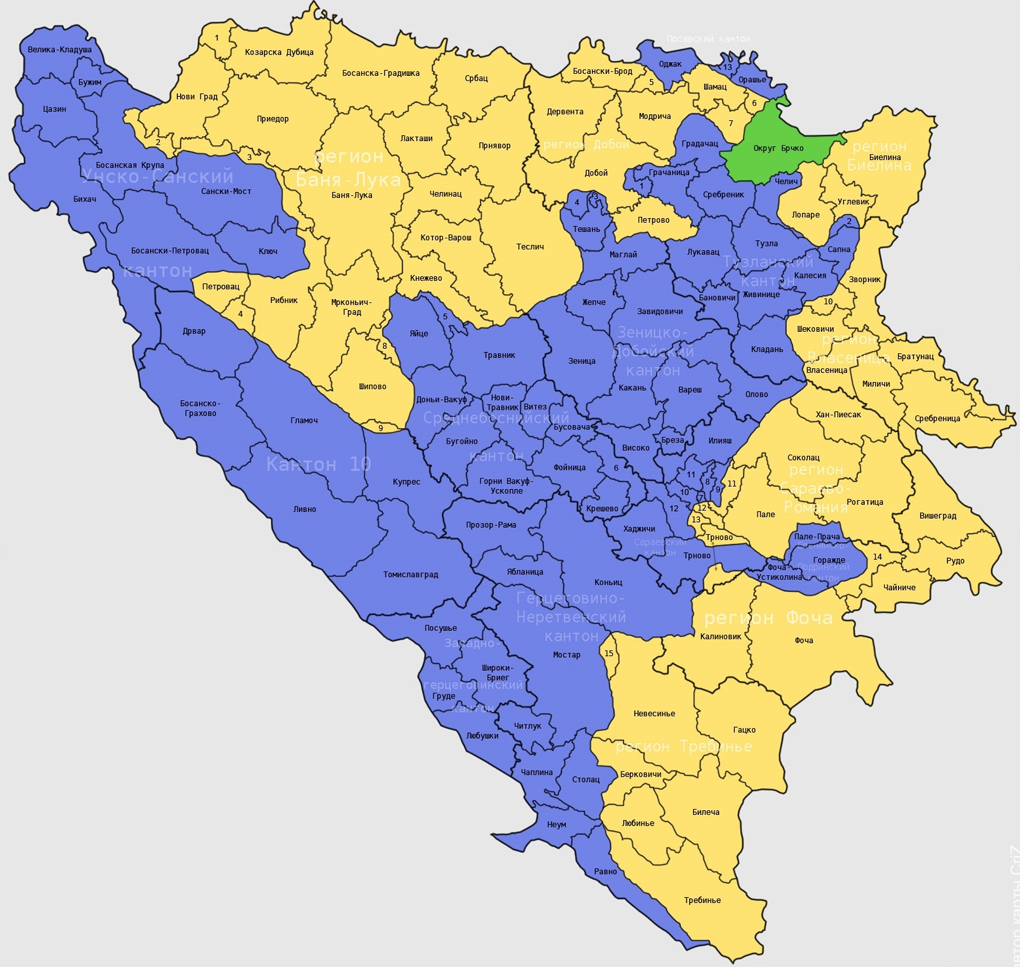Climate
The inland Bosnia region has a moderate continental climate, with hot summers and cold, snowy winters. In the central and eastern
interior of the country the geography is mountainous, in the northwest moderately hilly, and in the northeast predominantly flatland.
The smaller southern region, Herzegovina, has a Mediterranean climate and mostly mountainous topography.
Geography
The country is mostly mountainous, encompassing the central Dinaric Alps. The northeastern parts reach into the Pannonian Plain,
while in the south it borders the Adriatic. The Dinaric Alps generally run in a southeast–northwest direction, and get higher towards
the south. The highest point of the country is the peak of Maglić at 2,386 metres, on the Montenegrin border. Major mountains include
Kozara, Grmeč, Vlašić, Čvrsnica, Prenj, Romanija, Jahorina, Bjelašnica and Treskavica. The geological composition of the Dinaric chain
of mountains in Bosnia consists primarily of limestone (including Mesozoic limestone), with deposits of iron, coal, zinc, manganese,
bauxite, lead, and salt present in some areas, especially in central and northern Bosnia.
Overall, nearly 50% of Bosnia
and Herzegovina is forested. Most forest areas are in the centre, east and west parts of Bosnia. Herzegovina has drier Mediterranean
climate, with dominant karst topography. Northern Bosnia (Posavina) contains very fertile agricultural land along the River Sava and
the corresponding area is heavily farmed. This farmland is a part of the Pannonian Plain stretching into neighboring Croatia and Serbia.
The country has only 20 kilometres (12 miles) of coastline, around the town of Neum in the Herzegovina-Neretva Canton. Although the
city is surrounded by Croatian peninsulas, by international law, Bosnia and Herzegovina has a right of passage to the outer sea.
History
Bosnia and Herzegovina has been settled since at least the Upper Paleolithic but permanent human settlement traces back to the Neolithic
age, during which time it was inhabited by cultures such as Butmir, Kakanj, and Vučedol. After the arrival of the first Indo-Europeans,
it was populated by several Illyrian and Celtic civilizations. Culturally, politically, and socially, the country has a rich but complex
history, having been first settled by the South Slavic peoples that populate the area today from the 6th through to the 9th centuries.
In the 12th century the Banate of Bosnia was established, which evolved into the Kingdom of Bosnia in the 14th century, after which it
was annexed into the Ottoman Empire, under whose rule it remained from the mid-15th to the late 19th centuries. The Ottomans brought
Islam to the region, and altered much of the cultural and social outlook of the country. This was followed by annexation into the Austro-
Hungarian Monarchy, which lasted up until World War I. In the interwar period, Bosnia and Herzegovina was part of the Kingdom of
Yugoslavia and after World War II, it was granted full republic status in the newly formed Socialist Federal Republic of Yugoslavia.
Following the dissolution of Yugoslavia, the republic proclaimed independence in 1992, which was followed by the Bosnian War, lasting
until late 1995 and culminating with the Dayton Agreement.
Tourism
According to projections by the World Tourism Organization, Bosnia and Herzegovina will have the third highest tourism growth rate in
the world between 1995 and 2020.
In 2018, 1.883.772 tourists visited Bosnia-Herzegovina, an increase of 44,1%, and had 3.843.484 overnight hotel stays, a 43.5% increase
from the previous year. Also, 71.2% of the tourists came from foreign countries.
In 2017, 1,307,319 tourists visited Bosnia and Herzegovina, an increase of 13.7%, and had 2,677,125 overnight hotel stays, a 12.3%
increase from the previous year. 71.5% of the tourists came from foreign countries.
In 2006, when ranking the best cities in the world, Lonely Planet placed Sarajevo, the national capital and host of the 1984 Winter
Olympic Games, as #43 on the list. Tourism in Sarajevo is chiefly focused on historical, religious, and cultural aspects. In 2010, Lonely
Planet's "Best in Travel" nominated it as one of the top ten cities to visit that year. Sarajevo also won travel blog Foxnomad's "Best
City to Visit" competition in 2012, beating more than one hundred other cities around the entire world.
Međugorje has become one of the most popular pilgrimage sites for Christians in the world and has turned into Europe's third most important
religious place, where each year more than 1 million people visit. It has been estimated that 30 million pilgrims have come to Međugorje
since the reputed apparitions began in 1981.
Bosnia has also become an increasingly popular skiing and Ecotourism destination. Bosnia and Herzegovina remains one of the last undiscovered
natural regions of the southern area of the Alps, with vast tracts of wild and untouched nature attracting adventurers and nature lovers.
National Geographic magazine named Bosnia and Herzegovina as the best mountain biking adventure destination for 2012. The central Bosnian
Dinaric Alps are favored by hikers and mountaineers, containing both Mediterranean and Alpine climates. Whitewater rafting is somewhat of
a national pastime, with three rivers, including the deepest river canyon in Europe, the Tara River Canyon.
Most recently, the Huffington Post named Bosnia and Herzegovina the "9th Greatest Adventure in the World for 2013", adding that the country
boasts "the cleanest water and air in Europe; the greatest untouched forests; and the most wildlife. The best way to experience is the three
rivers trip, which purls through the best the Balkans have to offer.
Attractions
Some of the tourist attractions in Bosnia and Herzegovina include:
- Sarajevo — the "Olympic City" or "European Jerusalem"; the scientific, cultural, tourist and commercial center of Bosnia and Herzegovina as well as its capital
- Vratnik — old town and Bijela Tabija fortress in Sarajevo
- Shrine of Our Lady of Međugorje, with Annual Youth Festival — the site of a Marian apparition and subsequent Catholic pilgrimage destination
- Mostar, the "City on Neretva" or "City of Sunshine" — the location of the UNESCO World Heritage Sites of Stari most and old-town Mostar
- Višegrad — location of the UNESCO World Heritage Site of the Mehmed Paša Sokolović Bridge
- Banja Luka — the "Green City", with sights such as the Kastel fortress and Ferhadija mosque
- Bihać and the waterfalls of the river Una within Una National Park
- Jajce — city of the Bosnian kings and the place where the Federal People's Republic of Yugoslavia was founded, Pliva lakes and waterfall
- Prijedor — featuring its Old City Mosque, Kozara National Park and, at Mrakovica, Bosnia's largest World War II monument
- The salt-lakes of Tuzla — birthplace of Meša Selimović
- The Neretva river and the Rakitnica river canyons in Upper Neretva
- The Trebižat river and its waterfalls at Kravica and Koćuša
- The Buna — with its spring and historic town of Blagaj
- The Lower Tara river canyon — the deepest canyon in Europe
- Sutjeska National Park — featuring the ancient forest of Perućica and the Sutjeska river canyon
- Počitelj — historical village
- Mount Bjelašnica and Jahorina — sites used during XIV Olympic Winter Games in 1984
- Neum — the only coastal city in Bosnia and Herzegovina with direct access to the Adriatic Sea
- Doboj and its 13th-century fortress
- Stolac — featuring the Begovina neighborhood and Radimlja tombstones
- Visoko — city of the Bosnian nobility and monarchy, historical capital of the Kingdom of Bosnia and the site of the alleged Bosnian pyramids
- Prokoško Lake in Fojnica
- Tešanj — one of Bosnia's oldest known cities
- Bijeljina — known for its agriculture and ethnic village Stanišić
- Lukavac — featuring Modrac Lake, the largest artificial lake in Bosnia and Herzegovina
- Travnik — the birthplace of Ivo Andrić and once the capital city of the Bosnia Eyalet
- Jablanica — Museum of Battle of Neretva and Old bridge destroyed by Yugoslav army in Second World War
- Ostrožac Castle — a 16th-century castle built by the Ottoman Empire and later expanded by the House of Habsburg
- Konjic — featuring Tito's underground nuclear bunker
- Drvar — featuring Tito's cave and great natural landscapes
Cuisine
Bosnian cuisine uses many spices, in moderate quantities. Most dishes are light, as they are boiled; the sauces are fully natural,
consisting of little more than the natural juices of the vegetables in the dish. Typical ingredients include tomatoes, potatoes, onions,
garlic, peppers, cucumbers, carrots, cabbage, mushrooms, spinach, zucchini, dried beans, fresh beans, plums, milk, paprika and cream
called Pavlaka. Bosnian cuisine is balanced between Western and Eastern influences. As a result of the Ottoman administration for almost
500 years, Bosnian food is closely related to Turkish, Greek, and other former Ottoman and Mediterranean cuisines. However, because of
years of Austrian rule, there are many influences from Central Europe. Typical meat dishes include primarily beef and lamb. Some local
specialties are ćevapi, burek, dolma, sarma, pilav, goulash, ajvar and a whole range of Eastern sweets. Ćevapi is a grilled dish of minced
meat, a type of kebab, popular in former Yugoslavia and considered a national dish in Bosnia and Herzegovina[192] and Serbia. Local wines
come from Herzegovina where the climate is suitable for growing grapes. Herzegovinian loza (similar to Italian Grappa but less sweet) is
very popular. Plum (rakija) or apple (jabukovača) alcohol beverages are produced in the north. In the south, distilleries used to produce
vast quantities of brandy and supply all of ex-Yugoslav alcohol factories (brandy is the base of most alcoholic drinks).








